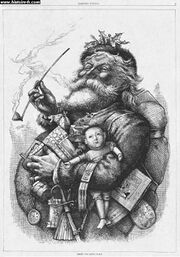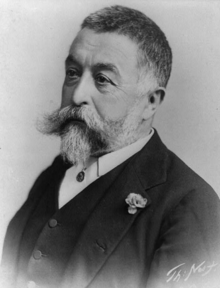Thomas Nast
| Thomas Nast | |||
|---|---|---|---|
| |||
| Born | September 27, 1840 Landau, German Confederation | ||
| Died | December 7, 1902 Guayaquil, Ecuador | ||
| Political Party | Republican | ||
| Spouse | Sarah Edwards Children: | ||
| Religion | Christian | ||
Thomas Nast (September 27, 1840 – December 7, 1902) is considered to be the greatest political cartoonist in American history. His cartoons created many images popular to this day, including:[1][2]

- the Republican Party elephant (still used today as the symbol of the Republican Party)
- the Democratic Party donkey (still used today as the symbol of the Democratic Party)
- Uncle Sam
- Santa Claus
Nast immigrated to the United States from Germany at the age of six, and was a staunch supporter of the Union during the American Civil War, when he first became popular as a cartoonist while in his early 20s.
His cartoons against the corruption in Tammany Hall were immensely effective against it.[3][4] A German Protestant immigrant himself, Nast was notably hostile to Irish Catholic immigrants and some of his cartoons reflected his anti-Irish and anti-Catholic prejudice.
Nast's works were effective and often elicited positive reception; one source commented:[4]
| “ | He not only enthralled a vast audience with boldness and wit, but swayed it time and again to his personal position on the strength of his visual imagination. | ” |
Contents
Career

During the American Civil War, Nast solidly supported the Union.[5] His cartoons at Harper's Weekly would attack those opposed to the war efforts (namely Northern Copperheads, or "Peace Democrats"[6]) against the Confederacy, and condemned slavery.[1] President Abraham Lincoln referred to Nast as:[1]
| “ | ...our best recruiting sergeant. | ” |
| —President Abraham Lincoln | ||
Indeed, Nast's blistering criticisms of George B. McClellan bolstered Lincoln's successful re-election campaign in 1864.[5] Nast also opposed the policies of Lincoln's successor, President Andrew Johnson. During the early Reconstruction period, his cartoons decried Johnson and the Democratic Party as ruthless racists and exemplified his bitterness towards weak policies against the South.[1]
A reoccurring theme in Nast's cartoons were the condemnations of the Democratic Party as a whole for their racism and intolerance, as opposed to only attacking certain factions. In his 1868 publication This is a White Man's Government, Nast showed that the Southern Confederates (symbolized by First Ku Klux Klan founder Nathan Bedford Forrest), ballot box stuffers, and Northern Irish Catholics all shared the same advocacy of white supremacy.[7]
Opposition towards Tweed and Irish Catholics
Nast's excoriation of Irish Catholics were of practically equal harshness as his disdain for Southern Confederates. His attacks against Catholic immigrants often portrayed them as un-American[8] and in degrading manners,[5] were attributed to his early life witnessing their frequent violence and atrocities in New York City.
In New York City, the sheer political corruption of Tammany Hall led by William M. "Boss" Tweed drew Nast's attention. Although Tweed boasted that his constituents were too illiterate to read reports by newspapers,[5] Nast's cartoons which exposed the corruption and hypocrisy of the political machine were effective in exposing Tammany Hall's scandals.[3][4] Tweed desperately attempted to bribe Nast to no avail, and faced arrest.
After being convicted, Tweed escaped from prison to Spain, where authorities encountered difficulties searching for him. Nast's cartoons proved successful in the capture of the Tammany Hall boss,[5] who was arrested and later died in jail in 1878.[3]
Support for Chinese immigrants
Nast's cartoons at Harper's Weekly frequently and consistently sympathized with the plight of Chinese immigrants to the United States who often faced racial discrimination and violence.[9] This was concurrent with his opposition towards the Irish, who were infamous for oppressing Chinese Americans during the era.[10]
Opposition towards Garfield, 1880
During the 1880 presidential election, Half-Breed dark house candidate James A. Garfield was nominated by the party convention to become the nominee in the general election. Nast resentment for Garfield's corruption and opposition towards Radical Republican-favored positions, in addition to his friendship with Democrat nominee Winfield S. Hancock, led to his support for the latter.[4]
Nast submitted a cartoon to Harper's Weekly that expressed support for Hancock, which the magazine rejected from publishing.[4] He then drew cartoons that assailed the Democratic Party as a whole while leaving out Hancock from them. This would mark the roots of Nast's increasing rifts with the magazine.
Nast opposes Blaine, breaks with Harper's Weekly
During the 1884 presidential election, Nast refused to support corrupt Half-Breed Republican nominee James G. Blaine,[4] who he actively despised,[11] instead joining the GOP Mugwump faction. His open support for Bourbon Democrat nominee Grover Cleveland instead led to disputes with other editors in Harper's Weekly, as well as additional complaints.[4]

Nast's breaks with Harper's Weekly editors only increased by 1885 due to differences over image production techniques,[5] middle-class cultural shifts, and the Republican Party.[4] His last cartoon published from the magazine was in the following year.[1] Although Nast's works would be published by other journals, they became infrequent.
Consequentially, Nast's opposition towards Blaine that handed Cleveland an election victory proved detrimental for Harper's Weekly in addition to his own career and standing. A source stated on the lose-lose outcome:[4]
| “ | In quitting Harper's Weekly, Nast lost his forum; in losing him, Harper's Weekly lost its political importance. | ” |
Death
Nast died in early December 1902 of yellow fever.[5] Harper's Weekly published in its obituary on him:[13]
| “ | He has been called, perhaps not with accuracy, but with substantial justice, the Father of American Caricature. | ” |
References
- ↑ 1.0 1.1 1.2 1.3 1.4 Thomas Nast. Britannica. Retrieved November 13, 2021.
- ↑ Uncle Sam. Britannica. Retrieved November 13, 2021.
- ↑ 3.0 3.1 3.2 Cartoon Analysis: Thomas Nast Takes on “Boss” Tweed, 1871. Bill of Rights Institute.
- ↑ 4.0 4.1 4.2 4.3 4.4 4.5 4.6 4.7 4.8 Wei, Stella (January 7, 2021). Thomas Nast: The Rise and Fall of the Father of Political Cartoons. Illustration History. Retrieved November 13, 2021.
- ↑ 5.0 5.1 5.2 5.3 5.4 5.5 5.6 McNamara, Robert (April 5, 2017). Thomas Nast. ThoughtCo. Retrieved November 13, 2021.
- ↑ Glass, Andrew (January 15, 2018). Dems' donkey rears its head in political cartoon, Jan. 15, 1870. Politico. Retrieved November 13, 2021.
- ↑ This is a White Man's Government. History Teaching Institute. Retrieved November 13, 2021.
- ↑ “The American River Ganges”. The Ohio State University. Retrieved November 13, 2021.
- ↑ Walfred, Michele (January 29, 2016). “Justice for the Chinese” 1886. Thomas Nast Cartoons. Retrieved November 13, 2021.
- ↑ Klein, Christopher (September 14, 2019). When America Despised the Irish: The 19th Century’s Refugee Crisis. HISTORY. Retrieved November 13, 2021.
- ↑ [James Blaine with "As speaker" and "R.R. jobs" letters sticking out of his back pocket and reaching for "the Mulligan letters" over "Blaine's record" hat]. Library of Congress. Retrieved November 13, 2021.
- ↑ Thomas Nast b&w film copy neg. Library of Congress. Retrieved November 13, 2021.
- ↑ Thomas Nast: Prince of Caricaturists. The Ohio State University. Retrieved November 13, 2021.
Further reading
- Lerner, Renée Lettow (2011). Thomas Nast's Crusading Legal Cartoons. The George Washington University Law School.
External links
- Illustrating Chinese Exclusion – Thomas Nast's Cartoons
- The Historic Elephant and Donkey – The New York Times, published August 2, 1908
- Profile at Find a Grave
